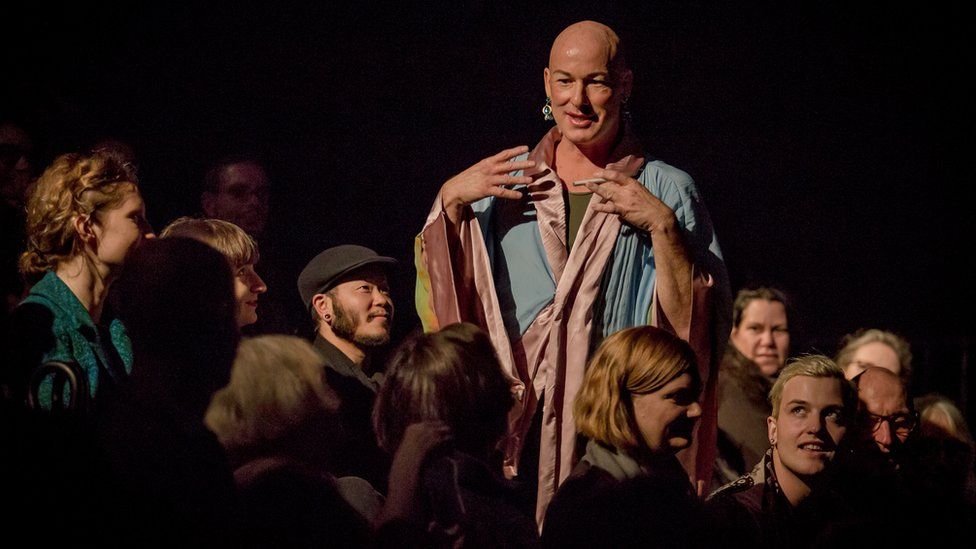Artist turns blood 'obsession' into stigma-busting show
- Published

Jacob Boehme remembers when he knew something was seriously wrong.
It was 1998 and Boehme had had a nagging cold for months. An Aboriginal elder "sat me in the middle of her legs and started to sing over me", he recalls. Performing a healing ceremony, she wiped the sweat from his armpits and smothered it on his head and neck. Eventually, she muttered: "Ahh, you need to go to a Western doctor. Everything is red. I cannot help you."
Boehme was diagnosed with HIV. In an era when antiretroviral treatments were in their infancy, it was the first news of its kind his doctor had delivered. "He was choked up and almost crying," Boehme says. "I had to console him."
Now 43, Boehme is not only still alive, he has put his experiences of being a gay, indigenous, HIV-positive man into a solo show. Blood on the Dance Floor, which just played at the Sydney Festival, explores what our understanding of blood means, from heritage to health.
Better portrayals
Combining storytelling and dance, the work includes a skit on being a camp "gay elder" in drag, discussion of stigma around HIV in the gay community (particularly when trying to find a partner), and moments when Boehme is framed, moving, against streams of blood, with bubbling red cells projected against the wall.
Most important, he says, is rewriting the conversation on what being HIV-positive means.
"Anything shown in the media or entertainment, it's always been some kind of memorialisation of the Aids crisis back in the '80s. Everybody dies," he elaborates.
"That's not relevant to me and to many of the other men and women that I know living with HIV. There isn't an image of a healthy functioning person with employment and prospects - you don't see that portrayed anywhere."
Another key step, he says, is broadening our understanding of who suffers from the virus. According to the University of New South Wales, notification rates (the reporting of newly-diagnosed cases) of indigenous men with HIV doubled in the past five years from 6.2 per 100,000 to 12.4 per 100,000. In contrast, non-indigenous notification rates fell by 12%, said the report by the university's Kirby Institute.
Despite this, education campaigns largely remain directed towards white men, says Boehme.
"Tell me the last time you saw an HIV education campaign with someone from the Aboriginal, Asian or African identity on those posters? You just see gay white men in their underwear," he points out.
"It makes quite a lot of people feel completely dismissed and it's not just the gay male community - it's heterosexual males living with HIV, kids living with HIV too. It's never been a gay white man's disease."
Stigma in communities
Born in Melbourne to a non-indigenous mother and father from the Narungga and Kaurna peoples of South Australia, Boehme knew he was gay from the age of four.
The dancer - who is the incoming creative director of the Melbourne Indigenous Arts Festival - has always had the support of his family.
Others are often not as lucky. In some Aboriginal communities, stigma towards homosexuality remains, insists Boehme.
"When you go into communities that are very much still holding up the values of the old mission days, that's when you get a problem, through those Christian and very Victorian ideas of sex, gender and sexuality," he says.
Blood on the Dance Floor was dreamed up after rehearsals in a warehouse. Boehme was "obsessed about my blood, about the cleanliness of my blood". After nicking his heel on an exposed nail, "I sat back down and realised I left a trail of blood on the dance floor. And [my friend] went 'ah, there's your title'."
"Blood, it's a life force that connects us, it can be used to define us and can be used to discriminate, to separate, or to actually unite," Boehme says.
Honouring a friend
When writing the show, the artist kept a small crystal decanter of his own blood on his desk. "Suddenly I was connected to my dad, then my grandmother, then a whole line of our ancestors that I never met and through that, those voices started to then speak through me. In that blood, in those codes, there are thousands of generations sitting in that little decanter."
Boehme says blood connects him to his past and, above all, to his illness. But it also releases him. "Regardless of what features or skin colour we have, really our blood is the thing that ties us together," he says.
A particularly raw moment in Blood on the Dance Floor touches on the suicide of Boehme's friend in 1996 after discovering he was HIV-positive. It was a time when "there was still this spectre hanging around like it was a death sentence. There was a lot more shame around HIV and he just couldn't cope."
Boehme still remembers when he found out. His friend's boyfriend, drunk, announced at a dinner party that his partner was positive. "I looked at him. And he said, 'I don't want that look. I don't want anyone's pity. Don't you dare give me that look.'"
Just two years later - as antiretroviral drugs were being rolled out to the larger population - Boehme received his own diagnosis. In Australia in the 1990s around 1,000 people died each year of Aids. Today, deaths are so low they are not recorded.
"That's exactly why I insisted we honour him," Boehme says of his friend. "He didn't get a chance."
If you are feeling emotionally distressed and would like details of organisations in the UK which offer advice and support, go online to bbc.co.uk/actionline. In Australia, you can find similar information at Lifeline and Beyond Blue.